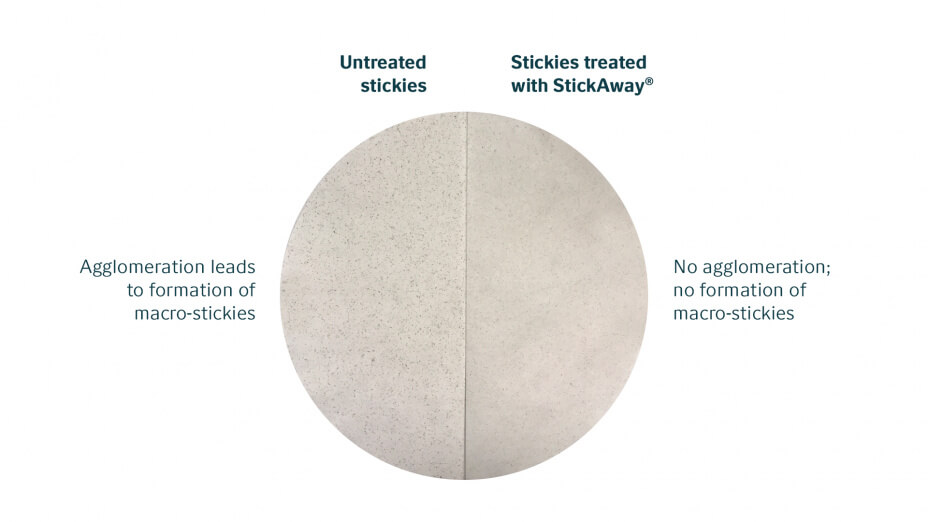StickAway®
StickAway® for stickies control in recycled pulps reduces deposition of problematic contaminants. That boosts your production efficiency and the quality of your final product.
Suited to recycled pulps
This product prevents the agglomeration of stickies in recovered feedstocks. That reduces deposition on your equipment. It also improves the quality of your final products.
Improved capacity
With this product you can reduce deposits on wires, felts, rolls and cans. This reduces paper machine breaks, increases energy efficiency and improves overall runnability. That means reduced downtime which improves your production capacity.
Improved product quality
By reducing holes, blemishes and spots, this product improves the appearance, strength and performance of your paper and board.
Accumulation and deposition of stickies increases downtime and cleaning frequency for your felts and rolls. This product stabilizes stickies to reduce the rate of deposition on your machine.

For demonstration purposes, we added much higher concentrations of stickies (final concentration: 0.02g dry sticky material/1.2 g fiber) and enzyme dosage than typical of real mill conditions. We solubilized sticky material (2%w/v) from a mill in acetone. We then injected 1ml of this solution into 200ml of buffer without StickAway®, and 200ml of buffer with StickAway®. We added each of these into two pulp suspensions when forming handsheets.
Which product is right for you?
Find the right solution for you in our global portfolio, shown below. To find out more about products available in your region, get in touch with your local Novozymes representative.
Lipases break down triglycerides in wood pitch. Esterases reduce the tackiness of stickies in recycled fiber. The result is reduced deposits on wires, felts, rolls and cans.
In mechanical pulp processes, triglycerides and resins are released and remain with the pulp. These substances can cause serious problems in paper and board production. They accumulate and form pitch deposits on wires, felts, rolls and dryer cans and even carry into the final product. The result is more frequent shutdowns and inferior paper quality. Lipases selectively degrade triglycerides into mono- and di-glycerides and free fatty acids. The free fatty acids can be washed away from the pulp or anchored onto the fibers by use of alum or other fixatives.
Lipase treatment significantly reduces the level of pitch deposition on the paper machine. It also reduces the number of defects on the paper web. Treating mechanical pulps with lipases can also remove triglycerides from fiber surfaces. The result is improved interfiber bonding. That allows paper mills to avoid or reduce the use of costly chemical pulp fibers for supplemental strength.
Most mills that consume recovered fiber experience problems with stickies. Sources of stickies include pressure-sensitive adhesives, hot melts, waxes and binders. As the name suggests, stickies are tacky particles. That means they have a tendency to agglomerate. When small and dispersed, stickies are relatively benign. However, stickies can rapidly agglomerate into larger particles with unique surface properties. At a certain point, these particles form deposits on paper mill process equipment and finished product.
Stickies often contain significant amounts of polyvinyl acetate or acrylate. Esterase enzymes target these esters, modifying their surface to reduce stickiness. The result is reduced potential for agglomeration and lower levels of macro stickies.